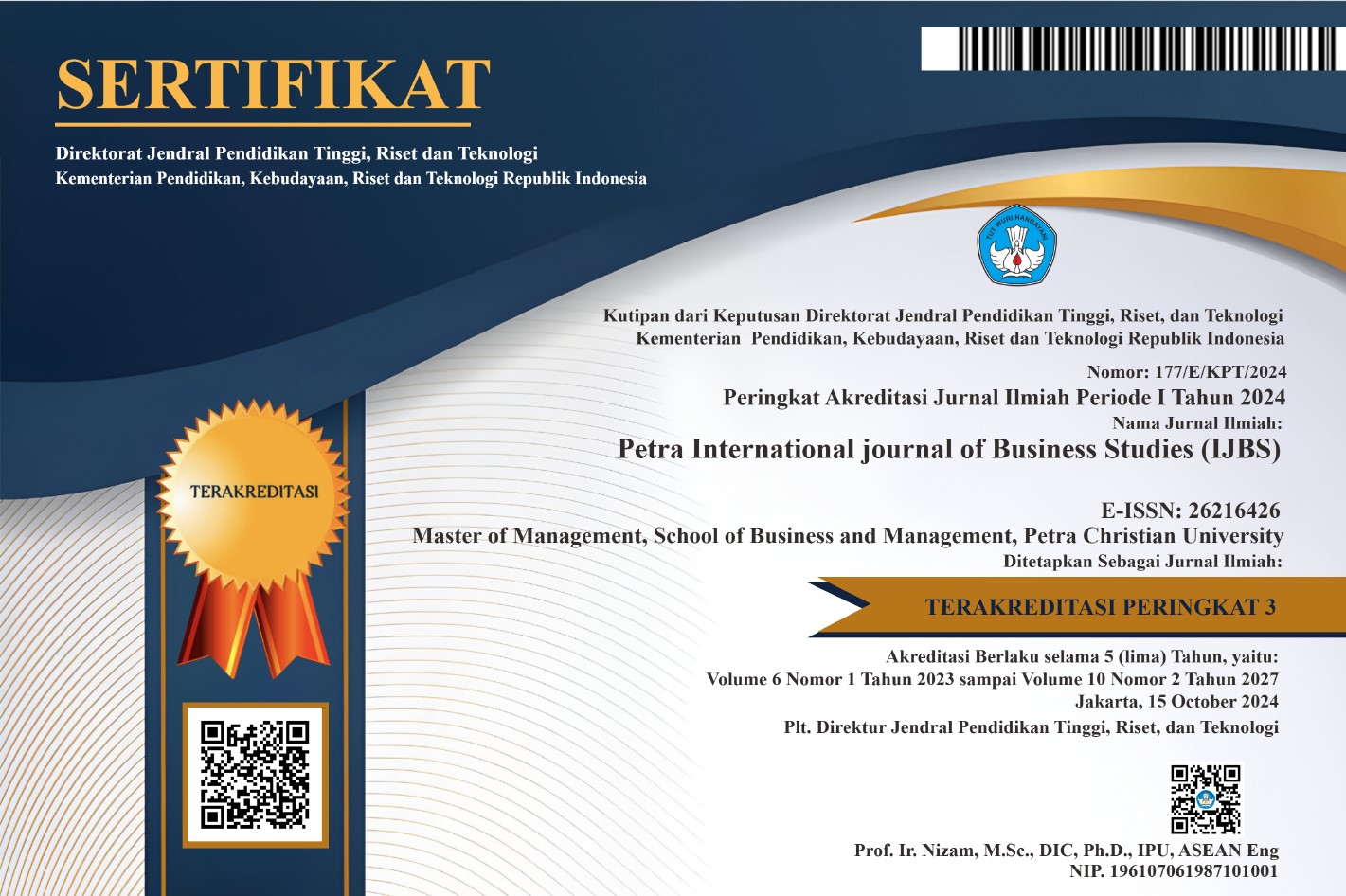Public Relations Marketing Strategy of SMP Negeri 4 Surakarta in Maintaining Good Communication with Stakeholders
DOI:
https://doi.org/10.9744/petraijbs.7.1.1-10Keywords:
Public Relations, Marketing Strategy, CommunicationAbstract
This study aims to find out the marketing strategy of the SMP Negri 4 Surakarta in maintaining good communication with the stakeholders. This descriptive qualitative research uses interviews and observations to gain the data. This research is also exploratory because it seeks to explore the right multimedia-based public relations strategy for managing information media at SMP Negeri 4 of Surakarta. Field findings show that a lack of human resource literacy in managing school information media causes problems in the less-than-optimal organizational system or management of school information media. Based on the first year of research findings, the Inflorescence Model describes the flow of school information media management. The researchers use purposive sampling to pick individuals who are knowledgeable about SMP Negeri 4 Surakarta's marketing strategy, digital media management, and public relations. School administrators, instructors, public relations officers, and other relevant stakeholders may be included. Researchers transcribed interviews, organized observation notes, and documented data before identifying reoccurring themes and patterns in the data. Researchers will code the data by methodically identifying and categorizing information relevant to the research aims. Researchers will examine the data after it has been coded, looking for relationships, connections, and insights. To assure the legitimacy and integrity of the outcomes, researchers may compare findings from different participants and data sources. The analysis's findings will be reported in a research paper or report arranged around main themes, findings, and conclusions. The result of this study is that the marketing public relations strategies in maintaining good communication with its stakeholders are preparing modules for teachers, school managers, and readers to build, develop, and promote the management of structured digital-based school media and fostering literacy rates in schools. Another strategy step is to implement an evaluation system from the information media to identify existing deficiencies and make improvements in the future. Push, Pull, and Pass strategy approaches and digital marketing tools are also used to implement the strategy and maintain good stakeholder communication.
Downloads
References
As’ad H, & Anas Y, A. R. (2014). The impact of social media marketing on brand equity: An empirical study on mobile service provider in Jordan. Science Private University, 3(1), 315-326.
Braun Simon. (2022). Crisis communication by school leaders during the COVID-19 global pandemic. Royal Roads University. doi: 10.1177/08920206221084050
Brocato, D. (2010). Push and pull marketing strategies. In Wiley International Encyclopedia of Mar-keting. Chichester, UK: John Wiley & Sons, Ltd. https://doi.org/10.1002/9781444316568.wiem01053
Broom, G. M., & Sha, B.-L. (2013). Cutlip and center’s effective public relations, Prentice Hall
Charmaz, K. (2014). Constructing grounded theory (2nd ed.). SAGE Publications Ltd.
Cornelissen, J. (2017). Corporate communication : A guide to theory & practice (5th ed.). USA: Sage Publication Ltd.
Clark, J. L., Algoe, S. B., & Green, M. C. (2018). Social Network Sites and Well-Being: The Role of Social Connection. Current Directions in Psychological Science, 27(1), 32-37. https://doi.org/10.1177/0963721417730833.
Creswell, J. W. (2013). Qualitative inquiry and research design: choosing among five approaches (3rd ed.). SAGE Publications Ltd.
Denzin, N. K., & Lincoln, Y. S. (2018). The Sage handbook of qualitative research (5th ed.). California: SAGE Publications Ltd.
Effendi, O. U. (2017). Ilmu komunikasi teori dan praktek (28th ed.). Bandung: Remaja Rosda Karya.
Effendy, O. U. (2015). Perencanaan dan strategi komunikasi. Bandung: Rosdakarya.
Fill, C. (2013). Marketing communications: Brands, experiences and participation. Pearson Education Limited.
Heidi, C. (2015). Content marketing distribution: Pull vs Push (Chart). Retrieved June, 2024, https://heidicohen.com/content-marketing-distribution-pull-vs-push-chart/
Jain, A., & Raja Sankaran, D. (2022). A study on digital marketing and its impact on consumer purchase decision. Shanlax International Journal of Management, 9(S1-Feb), 259–269. https://doi.org/10.34293/management.v9iS1.4867
Kotler, P., & Lee, N. R. (2004). Corporate Social Responsibility: Doing the most good for your company and your cause. John Wiley & Sons.
Mahalaxmi, K. R., & Ranjith, P. (2016). A study on impact of digital marketing 69 in customer purchase decision in Trichy. International Journal for Innovative Research in Science & Techno¬logy, 2(10), 332–338.
Mansour, B., & Mupinga, D. M. (2007). Students’ positive and negative experiences in hybrid and online classes. College Student Journal, 41(1), 242–248.
Morissan. (2008). Manajemen media penyiaran: strategi mengelola radio dan televisi. Jakarta: Kencana Prenada Media Group.
Pace, R. W., Peterson, B. D., & Burnett, M. D. (1979). Techniques for effective communication. Addison Wesley Publishing Company.
Palloff, R. M., & Pratt, K. (2013). Lessons from the virtual classroom: The realities of online teaching. John Wiley & Sons.
Priansa, D. J. (2017). Komunikasi pemasaran terpadu: pada era media sosial. Bandung: Pustaka Setia.
Purnama, B. J. (2016). Optimalisasi manajemen sumber daya manusia dalam upaya peningkatan mutu sekolah. Jurnal Manajemen Pendidikan, 12(2), 27-36.
Putri, P. M., & Marlien, R. . (2022). Pengaruh digital marketing terhadap keputusan pembelian online. Jesya (Jurnal Ekonomi & Ekonomi Syariah), 5(1), 25–36. https://doi.org/10.36778/jesya.v5i1.510
Ruslan, R. (2010). Manajemen public relations & media komunikasi: Konsepsi dan Aplikasi (edisi revisi) (Ed.Rev). Jakarta: PT. Raja Grafindo Persada.
Schultz, D. E., Patti, C. H., & Kitchen, P. J. (2018). Integrated marketing communication in retrospect and prospect. Journal of Advertising Research, 58(2), 111–116.
Trianto. (2010). Mendesain model pembelajaran ino-vatif-progresif, konsep landasan dan implemen-tasi¬nya. Jakarta: Kencana Prenada Media Group.
Vanel, Z., Wijaya, L. S., & Huwae, G. N. (2022). Strategi public relations dalam pengelolaan media digital sekolah. WACANA: Jurnal Ilmiah Ilmu Komunikasi, 21(1), 25–35. https://doi.org/10.32509/wacana.v21i1.1691
Varey, R. (2002). Marketing communication: A critical introduction. Routledge.
Vaughan, T. (2011). Multimedia: Making it work (8th ed.). New York: McGraw-Hill.
Wilis, R. A., & Faik, A. (2022). The effect of digital marketing, influencer marketing and online customer review on purchase decision: A case study of cake shop “Lu’miere.” Petra International Journal of Business Studies, 5(2), 155–162. https://doi.org/10.9744/ijbs.5.2.155–162
Additional Files
Published
Issue
Section
License
Copyright (c) 2024 Zon Vanel, Lina Sinatra Wijaya, George Nicholas Huwae

This work is licensed under a Creative Commons Attribution 4.0 International License.
Petra IJBS (e-ISSN: 2621-6426) is published by Master of Management program, School of Business and Management, Petra Christian University, Indonesia (MM SBM PCU).












